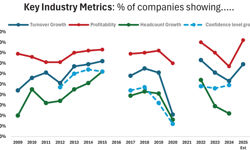The challenge of predicting what the consumer publishing company of the future will look like is a daunting one. I'm pretty sure the budgets I've just put together for 2013 have an element of fiction to them and sometimes, after a weekend away from the office, it feels like the sands of our media world have shifted… again.
Heading up the technology group at Future Publishing does give me a wonderfully early insight into the devices that will dominate our lives and allows me to work with creative talent that really understand how these technological advances are changing the way we consume media. For example, no one knows tablet publishing better than the team on T3 - they got there first. They didn’t suspect that the iPad would be huge, they knew it - so they grabbed hold of the platform and haven't let go since. Equally, no one knows how to squeeze the juices out of the internet better than the techradar.com team.
But even with all their insight, experience and non-traditional, unrestrained thinking, these guys would only be able to guess at what the future for consumer publishing looks like. It's clear that whatever it is, it isn't what we are doing now. And it’s equally clear that digital will be at the heart of every publisher’s business model in the way it just isn’t at present.
I like to think that Future is one of the UK’s most forward thinking publishers. The work that the team has put in to "cracking the tablet opportunity" has been award-winningly good; Future became the first publisher to win the AOP Digital Publisher of the Year Award two years running (2011 and 2012).
So Future is as good a place as any to ask how can consumer publishers “future proof” their business…
So what are we thinking? As I see it, all publishers are at the point where if we don't tackle these new challenges, things could get even bumpier - global recession or not. The option of always reverting back to the comfort zone of large circulation print-based magazines is gone, as the recent ABCs have shown.
What follows touches on a few themes that will be at the core of defining how publishing companies will operate in the coming years.
1. Tablets are here for good.
For us, the iPad can't grow quick enough, Google, Microsoft, Samsung or Amazon can't get their iPad-killer strategy sorted soon enough and the various alternative digital newsstands, from Windows 8 to Google Play, can't learn from or improve on the App store effectively enough.
Tablet publishing is now a totally engrained part of what we do at Future and it's a leadership position we are aggressively building on. When the "tablet ninjas" who built our in-house digital edition platform, FutureFolio, held some learning lunches, 75% of the company signed up to go along. The other 25% were already well versed in the whole subject matter.
2. All things mobile.
Every day, I get sent a new statistic on mobile usage. Apparently, I will be using my mobile so often, that I will have to wake up before I go to sleep in order to fit in the 38 hours of mobile usage that awaits me. My summary of all these stats is quite simple – mobile is really, really important.
And once we've all accepted that, I'll be buggered if I can find anyone with a compelling view of what to do next. So at Future, we are naturally trying to work that out ourselves. Many of our sites already have over 20% of their traffic coming from smartphones, although, suffice to say, we aren't quite getting 20% of the online revenue from these mobile optimised sites.
We really are learning the internet all over again with this one, but as smartphone screens get bigger, then web browsing will get more and more user-friendly.
But building the display revenue model for mobile is clearly only one part of the mix. I'm betting on sponsored posts, overlays and more interruptive ad types - alongside a more limited use of traditional formats such as banners.
The real mobile money is clearly in apps. The development of successful smartphone apps isn't something that any UK consumer publisher has excelled at. But there is obviously gold in them thar hills and as producers of compelling content in all forms - video, reviews, news, training, advice, lifestyle etc - we clearly have a great opportunity. But I believe the thing getting in our way is legacy. How can we find time to invest in such a new area as app development when we have these printed things to think about every week / month?
3. The diminishing role of the printed magazine.
In order to think of building new revenues, future proofing consumer publishing has to think of life without magazines. At present, that's pretty difficult to do, given that it’s where the majority of revenues come from, but the recent ABCs have once again sounded the alarm with some massive brands declining 20% in a year and that decline isn't stopping anytime soon.
We really need to make sure our best talents are aware of the challenge and are being given the time and structure to think beyond the magazine. It’s surely wrong to hire that talented new editor to come into that high profile magazine brand and give him / her the impossible and arguably pointless challenge of “reviving copy sales”. That talent must be used to take advantage of the bigger opportunity. We need to become the sort of organisations, the sort of industry that attracts the next wave of creative talent who are inspired by how our content connects with its audience. And it's clear that this connection is unlikely to be via print.
BUT, it's a modulated relationship with print. My eleven year old son loves Tuesdays. It’s not that he dislikes the other days in the week, it’s just that Tuesday sees his copy of Match magazine delivered in time for his arrival back from school. My nine year old daughter has a similar reaction about her Moshi Monsters magazine, though rather than get a subscription, she enjoys actually buying it from the newsagent. As someone who has worked on consumer magazines for around twenty years, I get a real kick from the fact that they get excited about the arrival of their favourite magazines. However, I am very aware that their relationship with these media products is very different to the relationship I had with the comics and mags of my youth.
My kids, like all kids, are surrounded by screens. I happily encourage them to use the iPad, smartphones and laptops and, to a lesser degree, the PlayStation. I talk to them about operating systems and browsers, apps and interfaces, Facebook, Twitter and YouTube. I am reassured that they are taught about computers and internet security at school, but I just want them to embrace the world that will dominate everything they do in the future. But even if I wasn’t openly encouraging, they would be swiping, taping, downloading and streaming regardless.
But they appear to be still reading magazines. And they don’t in any way see this as being strange or contradictory to the fact that they truly are digital natives. My son loves football and Match gives him posters and allows him to read about Arsenal or look at the new football boot while he is in bed (where screens are banned); my daughter loves Moshi Monsters and the licensed magazine is just part of that passion and the Moshi website doesn’t come free with stickers, transfers or plastic bracelets.
These print products have a role to play, but it is one that is alongside other increasingly dominant platforms.
4. Audience is everything.
Given the speed of change, I believe that we are in danger of forgetting the one thing that made the UK publishing industry successful in the first place.
The multitude of media platforms, new reading devices, the social media explosion and all things digital have created a huge level of distraction whereby technical requirements can get in the way of discussions about audience need. The perfect example is launching a tablet magazine to an audience that has a very low level of iPad ownership. I’m all for testing new opportunities, but if your audience simply isn’t there, it’s a huge waste of resources.
Equally, in the rush to try new things, we need to have the confidence to ask “why?”. The understandable noise around social media and the growth of Facebook and Twitter created a similar situation to the arrival of the iPad. Many brands rushed to drive up their follower numbers and their ‘likes’ without a plan about what on earth they were going to do with them. Or without an understanding on how their audience uses these networks.
My point is basically that, given the speed of innovation, a key element of the future proofing process must be publishers simply not forgetting what made them great in the first place – clear understanding of their audiences, months of work scoping, researching and refining content propositions, developing well targeted and compelling marketing plans with clear ROI and working through compelling advertising and commercial propositions. We need to beware of the start point being, “let’s launch a really cool iPad magazine or website with lots of video that’s perfectly optimised for mobile” and forget to spend enough time on asking questions such as, “what consumer problem are we solving”; “why would someone spend time with our new product”; “what value are we offering our commercial partners” and “will our audience keep coming back day after day, week after week or month after month”. Platform and technical discussions clearly have a key role to play, but the danger is that they can become overwhelming.
But the successful publishing company of the next decade will know everything about their audience and this will be built on a perfectly managed CRM strategy. Data will be at the heart of everything we do.
5. Diversification of revenues.
The wonderful thing about the arrival of the iPhone and the iPad is that they delivered clear irrefutable evidence that people will pay for content on digital platforms.
This has helped add another revenue stream, though for most, it is simply filling the gap left by declining copy sales. Getting people to pay for our content won’t be enough for publishing companies to grow, especially as the amount of content produced increases on a daily basis.
The publishing company of the next decade will need to expand the number of ways it generates revenue from the relationship it has with its audience. Simply building scale with online offerings won’t be enough as Agency Trading Desks take over the automated buying of digital campaigns. So adding uniquely integrated opportunities within a site that has a clear consumer proposition will become more important. Equally, the diversification of digital revenues will focus increasingly on publishers moving up the retail value chain.
Publishers’ relationships with their commercial partners and their agencies will need to become closer than ever as both strive to help each other’s business and delivery of objectives.
Finally, as we diversify our revenue models, it’s clear that we will all have to become more efficient with our costs. And as such, we will have to work even more closely as an industry, sharing best practice, sharing content, licensing each other’s platforms and building our own networks as and when a client or brief requires it.
6. Hybrid publishing.
At the heart of all this, the publishing company of the next decade will have to have a clear view of what they want to be. We all deal with brands, we all deal with audience connections and we are all looking to deliver a business off the back of this. Magazines were a profitable way of doing this; we just need to apply the same thinking, but across a multitude of areas. There will clearly be companies who specialise in certain platforms, however publishing companies like Future, who serve the specialist needs of their audiences, will be wholeheartedly working in a multi-platform world.
So, at the heart of the future proof process is the move towards becoming a true hybrid consumer media company where our growth comes from our ability to work across a multitude of platforms and user opportunities, capturing the optimal level of consumer and commercial revenues.












